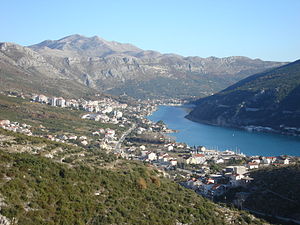Mokošica
Mokošica Nova Mokošica | |
|---|---|
Suburbs | |
 | |
 Mokošica | |
| Coordinates: 42°40′34″N 18°05′42″E / 42.67611°N 18.09500°E / 42.67611; 18.09500 | |
| Country | |
| County | Dubrovnik-Neretva |
| Municipality | Dubrovnik |
| Elevation | 0 m (0 ft) |
| Population (2001)[1] | |
| • Total | 7,528 |
| 1,487 Mokošica / 6,041 Nova Mokošica | |
| Time zone | UTC+1 (CET) |
| • Summer (DST) | UTC+2 (CEST) |
| Postal code | 20236 |
| Area code(s) | 020 |
| Licence plate | DU |
Mokošica is a district in the city of Dubrovnik in Croatia.[2] The suburb consists of Old (Mokošica) and New Mokošica (Nova Mokošica). At the 2001 census, it had a population of 7,528. It is considered one of the most densely populated urban districts in Croatia.
Contents
1 Name
2 Geographical location
3 History
4 New Mokošica
5 Economy
5.1 Transportation
5.2 Population
6 References
7 External links
Name
Mokošica was named after Mokosh, the goddess of fertility and protector of women in Slavic mythology.
Geographical location
Mokošica is the first major western suburban town of Dubrovnik (7 km from Dubrovnik). It is located just above the Adriatic Highway which leads to Split. From the north and east it is surrounded by the high mountains of the Dalmatian coast. Towards the north lies the slopes of Golubov Kamen Hill.
History
From the 16th century onwards Mokošica was the summer location for the citizens of Dubrovnik (House of Bona, Zuzorić, Ragnina and Giorgi). The most important building is Gozze-Giorgi(Sabino Giorgi) villa where, in 1814, the council met for the last time to restore the Republic of Ragusa. Nearby, there is Mokošica Villa Zamagna with a small chapel as well as ruins of a medieval church St. Pancras.
During the Homeland War, from November 1991 until May 1992, New and Old Mokošica were occupied by the Yugoslav People's Army (JNA),[3]Serbian and Montenegrin armies. New Mokošica recorded less destruction than the old town. It is believed that this was the case because members of guerrilla units were stationed in Old Mokošica.
New Mokošica
New Mokošica consists of three residential units, that were built in three phases. New urban development dates back to the early 1980s when the first multi-storey dwellings were built. The terrain on which New Mokošica is located abounds with olive groves, vineyards and fields. There are now residential buildings, a primary school sports hall, a kindergarten, health centre, cafes, shops, bank, bakery, post office, betting shops, playgrounds for children and sports courts for adults. There are plans to construct a new church and a large shopping centre.
There is a large number of high-rise buildings that were built in the 1980s and the beginning of the 1990s. The second and third phase of construction involved the evolution of "Our House" to "Small houses". Typical homes are residential buildings of three to four-stories, while the so-called Small houses or urban villas consist of up to two floors and four rooms per house. In 2005, the fourth phase of construction of new buildings from the housing incentive program (POS) began. This has resulted in an entirely new look for the area.
Economy
The vast majority of employees in Mokošica work in Dubrovnik. Main branches of economy in Mokošica are tourism, shipbuilding and fishing. There are plans to construct a large shopping centre and consequently the development of trade.
In the immediate vicinity of Komolac there is a marina. ACI Marina Dubrovnik in Komolac is the holder of a blue flag, and is located near the source of the river Ombla. The marina is completely protected from storm waves and the sea. It is considered one of the safest marinas in the world.
Transportation
New Mokošica is connected to Dubrovnik by the Adriatic highway. The 7 kilometre journey is convered frequently by bus lines 1A and 1B of the transportation company Libertas.
Population
The vast majority of the population are Croats, with small percentages of Serbs and Bosnians. According to the 2001 census, New Mokošica had 6,041 inhabitants and Old Mokošica 1,487.
References
^ "SAS Output". Dzs.hr. Retrieved 2012-06-08..mw-parser-output cite.citationfont-style:inherit.mw-parser-output qquotes:"""""""'""'".mw-parser-output code.cs1-codecolor:inherit;background:inherit;border:inherit;padding:inherit.mw-parser-output .cs1-lock-free abackground:url("//upload.wikimedia.org/wikipedia/commons/thumb/6/65/Lock-green.svg/9px-Lock-green.svg.png")no-repeat;background-position:right .1em center.mw-parser-output .cs1-lock-limited a,.mw-parser-output .cs1-lock-registration abackground:url("//upload.wikimedia.org/wikipedia/commons/thumb/d/d6/Lock-gray-alt-2.svg/9px-Lock-gray-alt-2.svg.png")no-repeat;background-position:right .1em center.mw-parser-output .cs1-lock-subscription abackground:url("//upload.wikimedia.org/wikipedia/commons/thumb/a/aa/Lock-red-alt-2.svg/9px-Lock-red-alt-2.svg.png")no-repeat;background-position:right .1em center.mw-parser-output .cs1-subscription,.mw-parser-output .cs1-registrationcolor:#555.mw-parser-output .cs1-subscription span,.mw-parser-output .cs1-registration spanborder-bottom:1px dotted;cursor:help.mw-parser-output .cs1-hidden-errordisplay:none;font-size:100%.mw-parser-output .cs1-visible-errorfont-size:100%.mw-parser-output .cs1-subscription,.mw-parser-output .cs1-registration,.mw-parser-output .cs1-formatfont-size:95%.mw-parser-output .cs1-kern-left,.mw-parser-output .cs1-kern-wl-leftpadding-left:0.2em.mw-parser-output .cs1-kern-right,.mw-parser-output .cs1-kern-wl-rightpadding-right:0.2em
^ Sanja Klempic Bogadi & Sonja Podgorelec (December 2009). "Socio-Demographic Characteristics & Processes in Croatian Coastal Cities". Geoadria: 225. Retrieved 22 September 2010.... municipality of Zupa Dubrovacka ... Donje Obuljeno, Gornje Obuljeno, Knezica, Komolac, Mokosica, Nova Mokosica...
^ Srgja Pavlovi, Reckoning: The 1991 Siege of Dubrovnik and the Consequences of the War for Peace. Military & Political Dynamics of the Siege: The Kouchner Plan, announced on November 19, 1991, called for JNA forces advancing from the north-west to stop at the village of Mokosica. Page 68
External links
- http://www.adriatica.net/destinations/hrvatska/juzna-dalmacija/mokosica-dubrovnik_es.htm
| Wikimedia Commons has media related to Mokošica. |
